Basalt Tectonic Discrimination Using Combined Machine Learning Approach
Abstract
1. Introduction
2. Literature Review
2.1. Neural Fuzzy Inference System (NFIS)
2.2. Particle Swarm Optimization (PSO)
3. Problem Description and Research Contribution
3.1. Limitations of Conventional Discrimination Diagrams
- Restricted by the earlier data processing technique, the sampling method was adopted and the typical region was taken as a research example, thus the discrimination diagrams were obtained. Although the discrimination diagrams obtained have achieved great results, with the accumulation of massive geochemical data, the earlier discrimination diagrams may not be applicable. Plotting compiled global data on some classical discrimination diagrams illustrates the problem, with a significant amount of these data being misclassified (see Figure 1) [53]. There is also significant overlap among MORB, OIB and IAB samples.
- Binary or ternary discrimination diagrams are the most commonly used for basalt tectonic discrimination. In other words, only a few elements or element ratios are utilized, which could affect the discrimination effect. In addition, when information about related elements in a discrimination diagram is missing, the diagram is not available.
3.2. Feasibility of MLAs for Tectonic Discrimination
- MLAs originated from the era of big data, with strong adaptability to all kinds of data. As a classifier, SONFIS can be trained based on the geochemical data of a large number of basalt samples with known tectonic settings. For the samples with unknown tectonic settings, the geochemical data measured can be directly input into the trained SONFIS, then the corresponding tectonic setting can be easily acquired. When different data serve as to train the SONFIS, the model parameters update adaptively to get a new different classifier. In summary, the performance of the classifier is related to the quantity and quality of geochemical data trained.
- MLAs have no limit on the amount of input geochemical data. Theoretically, the more the effective information, the better the performance of the classifier. For samples with unknown tectonic settings, the classification effect of SONFIS is also still satisfactory even if some input data are missing. Therefore, the MLA-based classifiers have excellent compatibility and robustness.
4. Mathematical Principles of Main Algorithms
4.1. Neural Fuzzy Inference System (NFIS)
4.1.1. Layer 1: Fuzzification Layer
4.1.2. Layer 2: Product Layer
4.1.3. Layer 3: Normalization Layer
4.1.4. Layer 4: Defuzzification Layer
4.1.5. Layer 5: Output Layer
4.2. Particle Swarm Optimization (PSO)
5. Methodology
5.1. Overall Methodology: The Proposed Hybrid SONFIS Method
5.2. Methodology Implementation Procedure
5.2.1. Data Acquisition and Preprocessing
Dataset 1 with High-Dimensional Features
Dataset 2 with Low-Dimensional Features
5.2.2. Model Parameter Configuration
5.2.3. Model Performance Evaluation
5.2.4. Model Validation Scheme Design
6. Results and Discussion
6.1. Optimization Effect Verification
6.2. MLA Performance Comparison
6.3. Contrast with Conventional Discrimination Diagrams
6.4. Discussion: Applicability and Deficiency of MLA-Based Discrimination Method
7. Conclusions and Future Work
- It could be found from Section 6.1 that with the help of PSO, the overall classification accuracy of SONFIS was about 5% higher than that of NFIS optimized by manual adjustment and grid search. Compared with grid search-optimized NFIS, SONFIS was more complicated, but it demonstrated better classification performance, indicating that the combined model was worth exploring.
- SONFIS had excellent generalization capacity, since PSO could automatically search for optimal parameters for different datasets. SONFIS could also be accurately applied to both high-dimensional and low-dimensional datasets, which was valuable for the study of petrology and geochemistry.
- The comparative experiments show that SONFIS was competitive for the two datasets used, demonstrating classification accuracy over 90% for both datasets. Furthermore, more elements could be utilized by SONFIS, giving it a superior ability to avoid the unreliability of the discrimination results.
- The other five well-established MLAs were also excellent methods for the tectonic discrimination of basalts, showing that ML was a particularly useful and promising tool in geochemical research. The combination of large databases and ML techniques might yield unexpected results.
Author Contributions
Funding
Conflicts of Interest
References
- Vermeesch, P. Tectonic discrimination of basalts with classification trees. Geochim. Cosmochim. Acta 2006, 70, 1839–1848. [Google Scholar]
- Ryan, K.M.; Williams, D.M. Testing the reliability of discrimination diagrams for determining the tectonic depositional environment of ancient sedimentary basins. Chem. Geol. 2007, 242, 103–125. [Google Scholar] [CrossRef]
- Liu, K.; Liu, W.B. Machine learning and identification of the tectonic environment of basalt in the continental plate. Eng. Technol. Manag. 2017. [Google Scholar] [CrossRef]
- Vermeesch, P. Tectonic discrimination diagrams revisited. Geochem. Geophys. Geosyst. 2006, 7, Q06017. [Google Scholar] [CrossRef]
- Guo, Q.Q.; Xiao, W.J.; Windley, B.F.; Mao, Q.G.; Han, C.M.; Qu, J.F.; Ao, S.J.; Li, J.L.; Yong, Y. Provenance and tectonic settings of Permian turbidites from the Beishan Mountains, NW China: Implications for the Late Paleozoic accretionary tectonics of the southern Altaids. J. Asian Earth Sci. 2012, 49, 54–68. [Google Scholar] [CrossRef]
- Chen, C.; Ren, Y.S.; Zhao, H.L.; Yang, Q.; Shang, Q.Q. Age, tectonic setting, and metallogenic implication of Phanerozoic granitic magmatism at the eastern margin of the Xing’an-Mongolian Orogenic Belt, NE China. J. Asian Earth Sci. 2017, 144, 368–383. [Google Scholar] [CrossRef]
- Di, P.F.; Wang, J.R.; Zhang, Q.; Yang, J.; Chen, W.F.; Pan, Z.J.; Du, X.L.; Jiao, S.T. The evaluation of basalt tectonic discrimination diagrams: Constraints on the research of global basalt data. Bull. Miner. Petrol. Geochem. 2017, 36, 891–896. [Google Scholar]
- Ueki, K.; Hino, H.; Kuwatani, T. Geochemical discrimination and characteristics of magmatic tectonic settings: A machine-learning-based approach. Geochem. Geophys. Geosyst. 2018, 19, 1327–1347. [Google Scholar]
- Shi, Y.; Huang, Q.W.; Liu, X.J.; Krapež, B.; Yu, J.H.; Bai, Z.A. Provenance and tectonic setting of the supra-crustal succession of the Qinling Complex: Implications for the tectonic affinity of the North Qinling Belt, Central China. J. Asian Earth Sci. 2018, 158, 112–139. [Google Scholar]
- Ren, Q.B.; Li, M.C.; Han, S. Tectonic discrimination of olivine in basalt using data mining techniques based on major elements: A comparative study from multiple perspectives. Big Earth Data 2019, 1–18. [Google Scholar] [CrossRef]
- Mao, X.; Li, L.; Liu, Z.; Zeng, R.; Dick, J.M.; Yue, B.; Ai, Q. Multiple magma conduits model of the Jinchuan Ni-Cu-(PGE) deposit, northwestern China: Constraints from the geochemistry of platinum-group elements. Minerals 2019, 9, 187. [Google Scholar] [CrossRef]
- Wang, J.R.; Chen, W.F.; Zhang, Q.; Jin, W.J.; Jiao, S.T.; Wang, Y.X.; Yang, J.; Pan, Z.J. MORB data mining: Reflection of basalt discrimination diagram. Geotecton. Met. 2017, 41, 420–431. [Google Scholar]
- Wang, J.R.; Chen, W.F.; Zhang, Q.; Jiao, S.T.; Yang, J.; Pan, Z.J.; Wang, S. Preliminary research on data mining of N-MORB and E-MORB: Discussion on method of the basalt discrimination diagrams and the character of MORB’s mantle source. Acta Petrol. Sin. 2017, 33, 993–1005. [Google Scholar]
- Green, D.H. The origin of basaltic and nephelinitic magmas in the earth’s mantle. Tectonophysics 1969, 7, 409–422. [Google Scholar] [CrossRef]
- Wood, D.A. The application of a Th-Hf-Ta diagram to problems of tectonomagmatic classification and to establishing the nature of crustal contamination of basaltic lavas of the British Tertiary Volcanic Province. Earth Planet. Sci. Lett. 1980, 50, 11–30. [Google Scholar] [CrossRef]
- Zhang, Y.; Yu, K.; Qian, H. LA-ICP-MS analysis of clinopyroxenes in basaltic pyroclastic rocks from the Xisha Islands, northwestern South China Sea. Minerals 2018, 8, 575. [Google Scholar] [CrossRef]
- Shu, S.; Yang, X.; Liu, L.; Liu, W.; Cao, J.; Gao, E. Dual geochemical characteristics for the basic intrusions in the Yangtze Block, South China: New evidence for the breakup of Rodinia. Minerals 2018, 8, 228. [Google Scholar] [CrossRef]
- Di, P.F.; Chen, W.F.; Zhang, Q.; Wang, J.R.; Tang, Q.Y.; Jiao, S.T. Comparison of global N-MORB and E-MORB classification schemes. Acta Petrol. Sin. 2018, 34, 264–274. [Google Scholar]
- Yoder, H.S., Jr.; Tilley, C.E. Origin of basalt magmas: An experimental study of natural and synthetic rock systems. J. Petrol. 1962, 3, 342–532. [Google Scholar] [CrossRef]
- Hofmann, A.W.; White, W.M. Mantle plumes from ancient oceanic crust. Earth Planet. Sci. Lett. 1982, 57, 421–436. [Google Scholar] [CrossRef]
- Pearce, J.A.; Lippard, S.J.; Roberts, S. Characteristics and tectonic significance of supra-subduction zone ophiolites. Geol. Soc. Lond. Spec. Publ. 1984, 16, 77–94. [Google Scholar] [CrossRef]
- Zindler, A.; Hart, S. Chemical geodynamics. Ann. Rev. Earth Planet. Sci. 1986, 14, 493–571. [Google Scholar] [CrossRef]
- Sun, S.S.; McDonough, W.F. Chemical and isotopic systematics of oceanic basalts: Implications for mantle composition and processes. Geol. Soc. Lond. Spec. Publ. 1989, 42, 313–345. [Google Scholar] [CrossRef]
- Safonova, I.; Maruyama, S.; Kojima, S.; Komiya, T.; Krivonogov, S.; Koshida, K. Recognizing OIB and MORB in accretionary complexes: A new approach based on ocean plate stratigraphy, petrology and geochemistry. Gondwana Res. 2016, 33, 92–114. [Google Scholar] [CrossRef]
- Bi, J.H.; Ge, W.C.; Yang, H.; Wang, Z.H.; Tian, D.X.; Liu, X.W.; Xu, W.L.; Xing, D.H. Geochemistry of MORB and OIB in the Yuejinshan Complex, NE China: Implications for petrogenesis and tectonic setting. J. Asian Earth Sci. 2017, 145, 475–493. [Google Scholar] [CrossRef]
- Li, Y.Q.; Du, X.L.; Jin, W.J.; Du, J.; Zhang, Q.; Wang, J.R.; Ma, Z. A comparative study of olivine in mid-ocean ridge basalt (MORB), ocean island basalt (OIB) and island arc basalt (IAB). Chin. J. Geol. 2018, 53, 1228–1239. [Google Scholar]
- Pearce, J.A.; Cann, J.R. Ophiolite origin investigated by discriminant analysis using Ti, Zr and Y. Earth Planet. Sci. Lett. 1971, 12, 339–349. [Google Scholar] [CrossRef]
- Pearce, J.A.; Cann, J.R. Tectonic setting of basic volcanic rocks determined using trace element analyses. Earth Planet. Sci. Lett. 1973, 19, 290–300. [Google Scholar] [CrossRef]
- Pearce, J.A. Statistical analysis of major element patterns in basalts. J. Petrol. 1976, 17, 15–43. [Google Scholar] [CrossRef]
- Hirose, K.; Kawamoto, T. Hydrous partial melting of lherzolite at 1 GPa: The effect of H2O on the genesis of basaltic magmas. Earth Planet. Sci. Lett. 1995, 133, 463–473. [Google Scholar] [CrossRef]
- Farnetani, C.G.; Richards, M.A.; Ghiorso, M.S. Petrological models of magma evolution and deep crustal structure beneath hotspots and flood basalt provinces. Earth Planet. Sci. Lett. 1996, 143, 81–94. [Google Scholar] [CrossRef]
- Arndt, N.T.; Kerr, A.C.; Tarney, J. Dynamic melting in plume heads: The formation of Gorgona komatiites and basalts. Earth Planet. Sci. Lett. 1997, 146, 289–301. [Google Scholar] [CrossRef]
- Pearce, J.A.; Norry, M.J. Petrogenetic implications of Ti, Zr, Y, and Nb variations in volcanic rocks. Contrib. Mineral. Petrol. 1979, 69, 33–47. [Google Scholar] [CrossRef]
- Wood, D.A.; Joron, J.L.; Treuil, M. A re-appraisal of the use of trace elements to classify and discriminate between magma series erupted in different tectonic settings. Earth Planet. Sci. Lett. 1979, 45, 326–336. [Google Scholar] [CrossRef]
- Shervais, J.W. Ti-V plots and the petrogenesis of modern and ophiolitic lavas. Earth Planet. Sci. Lett. 1982, 59, 101–118. [Google Scholar] [CrossRef]
- Mullen, E.D. MnO/TiO2/P2O5: A minor element discriminant for basaltic rocks of oceanic environments and its implications for petrogenesis. Earth Planet. Sci. Lett. 1983, 62, 53–62. [Google Scholar] [CrossRef]
- Pearce, J.A.; Peate, D.W. Tectonic implications of the composition of volcanic arc magmas. Ann. Rev. Earth Planet. Sci. 1995, 23, 251–285. [Google Scholar] [CrossRef]
- Workman, R.K.; Hart, S.R. Major and trace element composition of the depleted MORB mantle (DMM). Earth Planet. Sci. Lett. 2005, 231, 53–72. [Google Scholar] [CrossRef]
- Galoyan, G.; Rolland, Y.; Sosson, M.; Corsini, M.; Melkonyan, R. Evidence for superposed MORB, oceanic plateau and volcanic arc series in the Lesser Caucasus (Stepanavan, Armenia). Comptes Rendus Geosci. 2007, 339, 482–492. [Google Scholar] [CrossRef]
- Petrelli, M.; Perugini, D. Solving petrological problems through machine learning: The study case of tectonic discrimination using geochemical and isotopic data. Contrib. Min. Petrol. 2016, 171, 81. [Google Scholar] [CrossRef]
- Wang, J.R.; Pan, Z.J.; Zhang, Q.; Chen, W.F.; Yang, J.; Jiao, S.T.; Wang, S.H. Intra-continental basalt data mining: The diversity of their constituents and the performance in basalt discrimination diagrams. Acta Petrol. Sin. 2016, 32, 1919–1933. [Google Scholar]
- Liu, X.L.; Zhang, Q.; Li, W.C.; Yang, F.C.; Zhao, Y.; Li, Z.; Jiao, S.T.; Wang, J.R.; Zhang, N.; Wang, S.S.; et al. Applicability of large-ion lithophile and high field strength element basalt discrimination diagrams. Int. J. Dig. Earth 2018, 11, 752–760. [Google Scholar] [CrossRef]
- Li, C.S.; Arndt, N.T.; Tang, Q.Y.; Ripley, E.M. Trace element indiscrimination diagrams. Lithos 2015, 232, 76–83. [Google Scholar] [CrossRef]
- Zhang, L. MATPLOT: A MATLAB standalone application for geochemical data analysis and plotting. Acta Petrol. Sin. 2018, 34, 495–502. [Google Scholar]
- GEOROC. Available online: http://georoc.mpch-mainz.gwdg.de/georoc/ (accessed on 20 June 2019).
- PetDB. Available online: http://www.earthchem.org/petdb (accessed on 20 June 2019).
- Zhang, Q.; Zhou, Y.Z. Reflections on the scientific research method in the era of big data. Bull. Mineral. Petrol. Geochem. 2017, 36, 881–885. [Google Scholar]
- Zhang, Q.; Zhou, Y.Z. Big data helps geology develop rapidly. Acta Petrol. Sin. 2018, 34, 3167–3172. [Google Scholar]
- Luo, J.M.; Zhang, Q. Big data opens up new way for geology study: Mining of all data enhances the researchful precision. Chin. J. Geol. 2018, 53, 1207–1214. [Google Scholar]
- Zhang, Q.; Jiao, S.T.; Lu, X.X. Discussion on causality and correlation in geological research. Acta Petrol. Sin. 2018, 34, 275–280. [Google Scholar]
- Zhou, Y.Z.; Chen, S.; Zhang, Q.; Xiao, F.; Wang, S.G.; Liu, Y.P.; Jiao, S.T. Advances and prospects of big data and mathematical geoscience. Acta Petrol. Sin. 2018, 34, 255–263. [Google Scholar]
- Han, S.; Li, M.C.; Ren, Q.B. Discriminating among tectonic settings of spinel based on multiple machine learning algorithms. Big Earth Data 2019. [Google Scholar] [CrossRef]
- Han, S.; Li, M.C.; Ren, Q.B.; Liu, C.Z. Intelligent determination and data mining for tectonic settings of basalts based on big data methods. Acta Petrol. Sin. 2018, 34, 3207–3216. [Google Scholar]
- Jiao, S.T.; Zhou, Y.Z.; Zhang, Q.; Jin, W.J.; Liu, Y.P.; Wang, J. Study on intelligent discrimination of tectonic settings based on global gabbro data from GEOROC. Acta Petrol. Sin. 2018, 34, 3189–3194. [Google Scholar]
- Trépanier, S.; Mathieu, L.; Daigneault, R.; Faure, S. Precursors predicted by artificial neural networks for mass balance calculations: Quantifying hydrothermal alteration in volcanic rocks. Comput. Geosci. 2016, 89, 32–43. [Google Scholar] [CrossRef]
- Ren, Q.B.; Wang, G.; Li, M.C.; Han, S. Prediction of rock compressive strength using machine learning algorithms based on spectrum analysis of geological hammer. Geotech. Geol. Eng. 2019, 37, 475–489. [Google Scholar] [CrossRef]
- Jang, J.S. ANFIS: Adaptive-network-based fuzzy inference system. IEEE Trans. Syst. Man Cybern. 1993, 23, 665–685. [Google Scholar] [CrossRef]
- Chen, M.Y. A hybrid ANFIS model for business failure prediction utilizing particle swarm optimization and subtractive clustering. Inf. Sci. 2013, 220, 180–195. [Google Scholar] [CrossRef]
- Basser, H.; Karami, H.; Shamshirband, S.; Akib, S.; Amirmojahedi, M.; Ahmad, R.; Jahangirzadeh, A.; Javidnia, H. Hybrid ANFIS-PSO approach for predicting optimum parameters of a protective spur dike. Appl. Soft Comput. 2015, 30, 642–649. [Google Scholar] [CrossRef]
- Bui, K.T.T.; Bui, D.T.; Zou, J.G.; Van Doan, C.; Revhaug, I. A novel hybrid artificial intelligent approach based on neural fuzzy inference model and particle swarm optimization for horizontal displacement modeling of hydropower dam. Neural Comput. Appl. 2018, 29, 1495–1506. [Google Scholar] [CrossRef]
- Shahnazar, A.; Rad, H.N.; Hasanipanah, M.; Tahir, M.M.; Armaghani, D.J.; Ghoroqi, M. A new developed approach for the prediction of ground vibration using a hybrid PSO-optimized ANFIS-based model. Environ. Earth Sci. 2017, 76, 527. [Google Scholar] [CrossRef]
- Boussaïd, I.; Lepagnot, J.; Siarry, P. A survey on optimization metaheuristics. Inf. Sci. 2013, 237, 82–117. [Google Scholar] [CrossRef]
- Tang, K.S.; Man, K.F.; Kwong, S.; He, Q. Genetic algorithms and their applications. IEEE Sig. Proc. Mag. 1996, 13, 22–37. [Google Scholar] [CrossRef]
- Marco, D.; Mauro, B.; Thomas, S. Ant colony optimization. IEEE Comput. Intell. Mag. 2007, 1, 28–39. [Google Scholar]
- Storn, R.; Price, K. Differential evolution–a simple and efficient heuristic for global optimization over continuous spaces. J. Glob. Optim. 1997, 11, 341–359. [Google Scholar] [CrossRef]
- Kennedy, J.; Eberhart, R.C. Particle swarm optimization. In Proceedings of the International Conference on Neural Networks, Perth, Australia, 27 November–1 December 1995; pp. 1942–1948. [Google Scholar] [CrossRef]
- Song, S.; Kong, L.; Gan, Y.; Su, R. Hybrid particle swarm cooperative optimization algorithm and its application to MBC in alumina production. Prog. Nat. Sci. 2008, 18, 1423–1428. [Google Scholar] [CrossRef]
- Momeni, E.; Armaghani, D.J.; Hajihassani, M.; Amin, M.F.M. Prediction of uniaxial compressive strength of rock samples using hybrid particle swarm optimization-based artificial neural networks. Measurement 2015, 60, 50–63. [Google Scholar] [CrossRef]
- Chatterjee, S.; Sarkar, S.; Hore, S.; Dey, N.; Ashour, A.S.; Balas, V.E. Particle swarm optimization trained neural network for structural failure prediction of multistoried RC buildings. Neural Comput. Appl. 2017, 28, 2005–2016. [Google Scholar] [CrossRef]
- Wang, D.; Tan, D.; Liu, L. Particle swarm optimization algorithm: An overview. Soft Comput. 2018, 22, 387–408. [Google Scholar] [CrossRef]
- Rini, D.P.; Shamsuddin, S.M.; Yuhaniz, S.S. Particle swarm optimization for ANFIS interpretability and accuracy. Soft Comput. 2016, 20, 251–262. [Google Scholar] [CrossRef]
- Shi, Y.; Eberhart, R. A modified particle swarm optimizer. In Proceedings of the IEEE World Congress on Computational Intelligence, Anchorage, Alaska, 4–9 May 1998; pp. 69–73. [Google Scholar] [CrossRef]
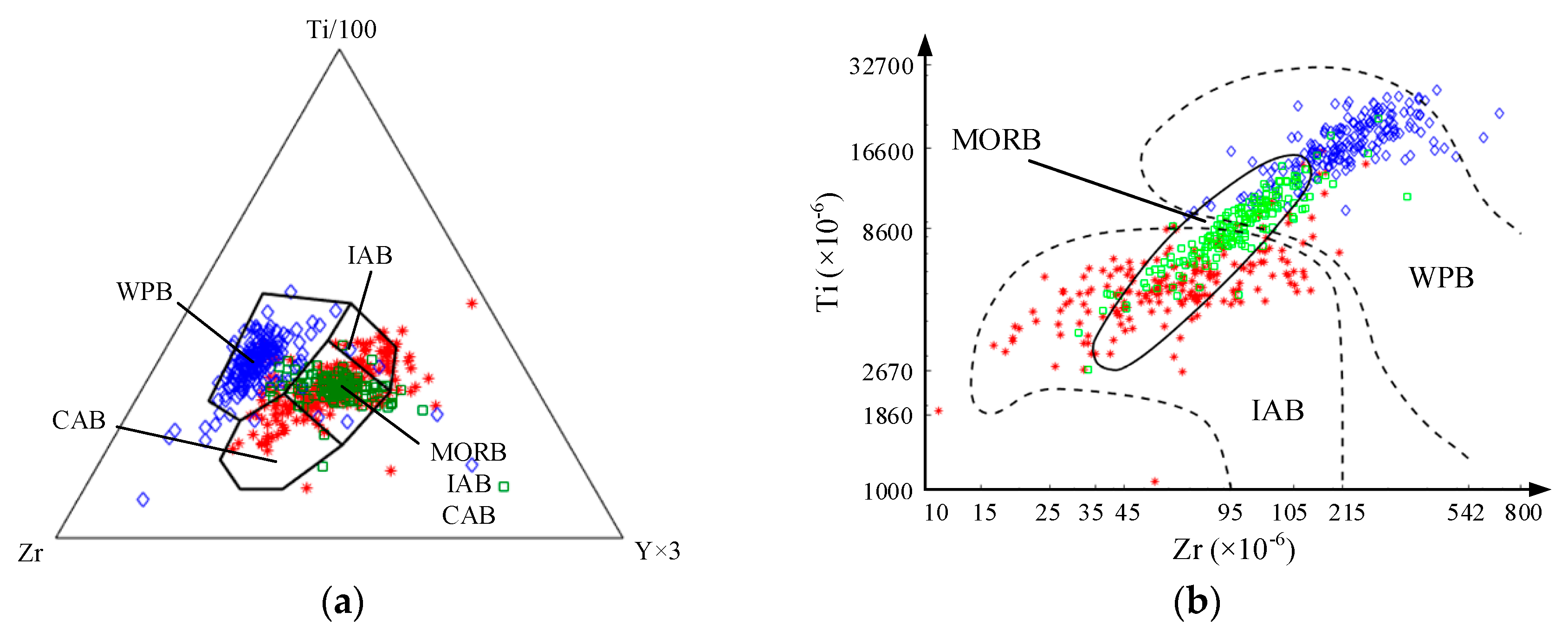

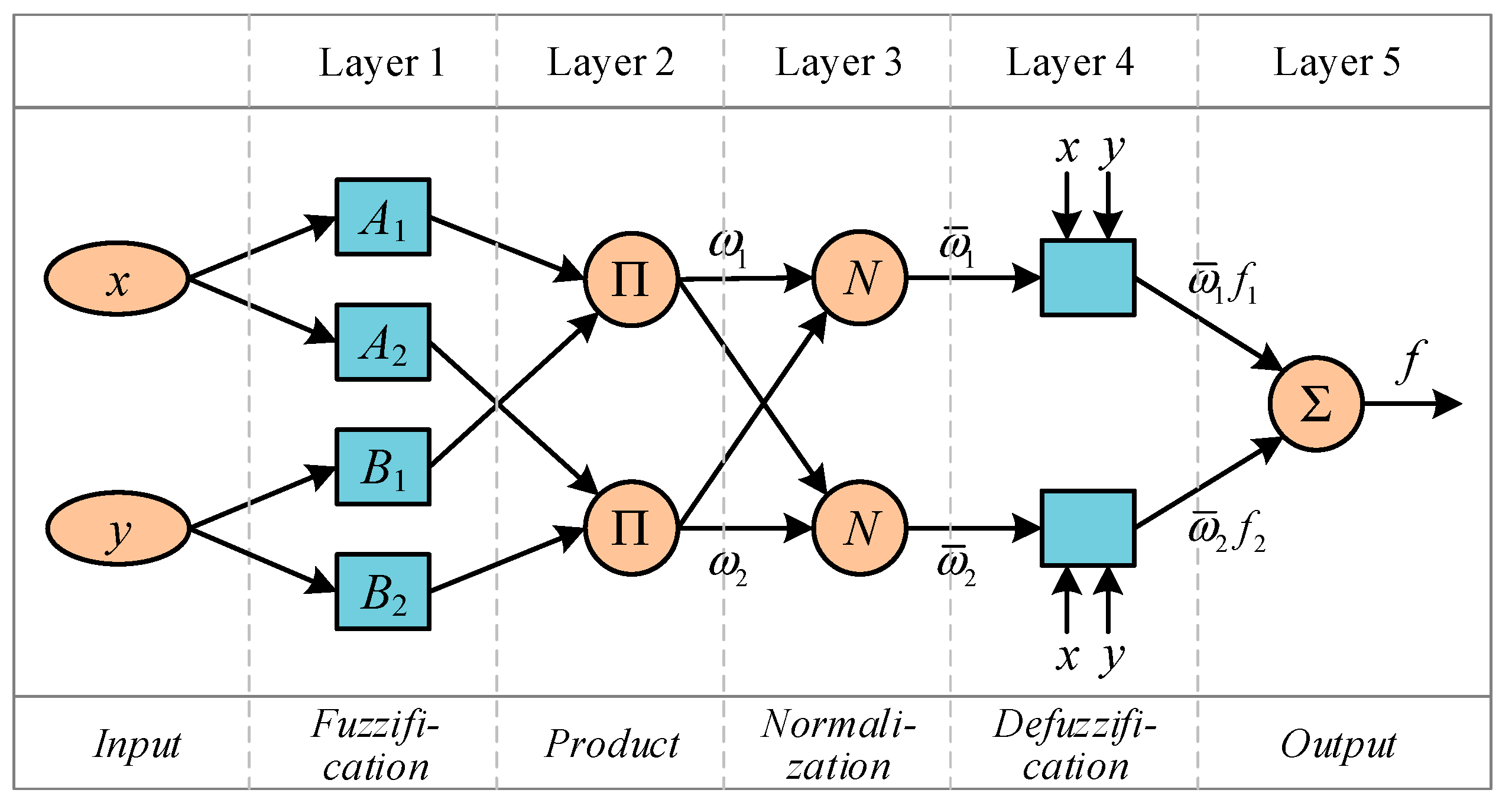
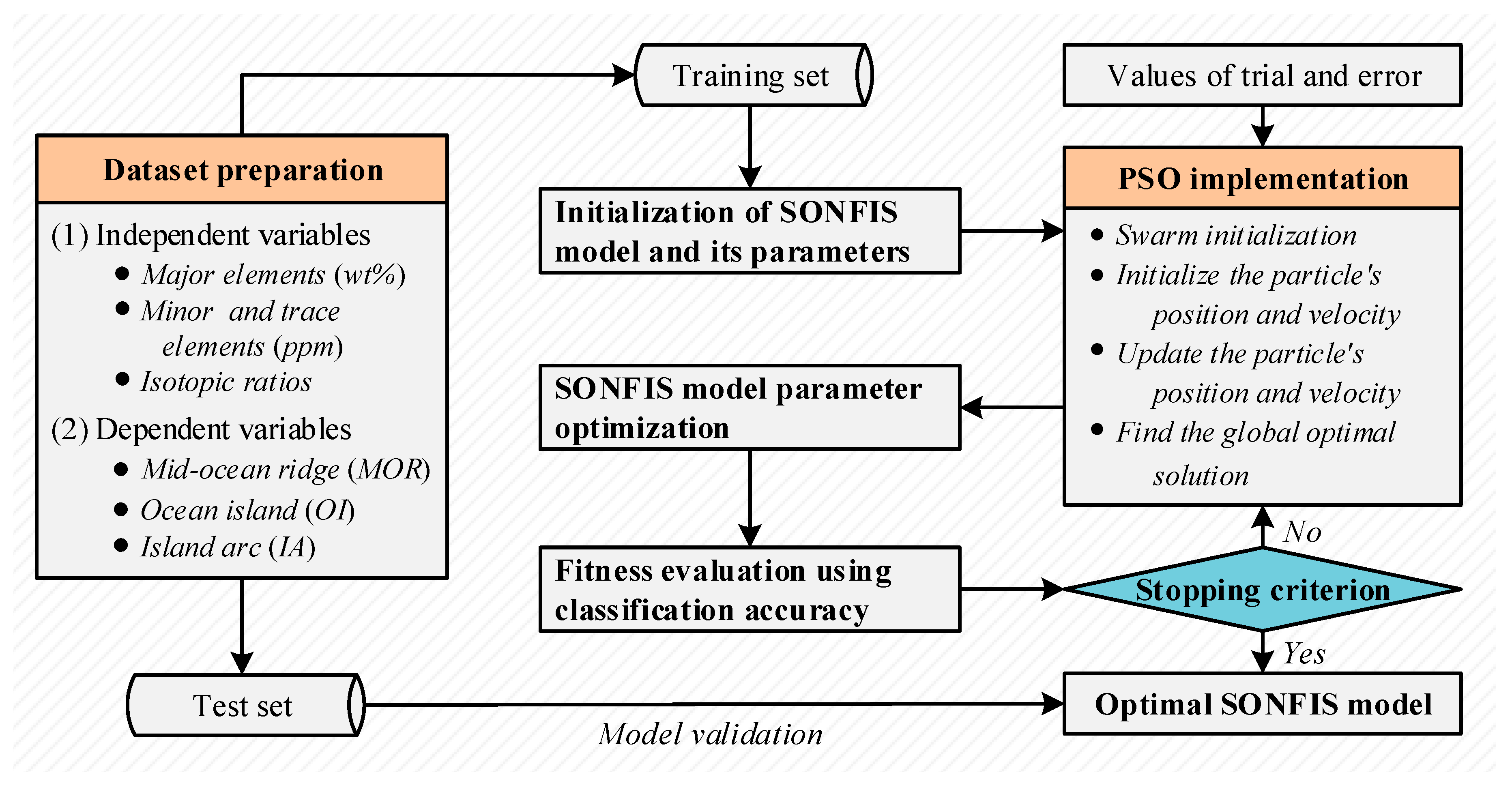
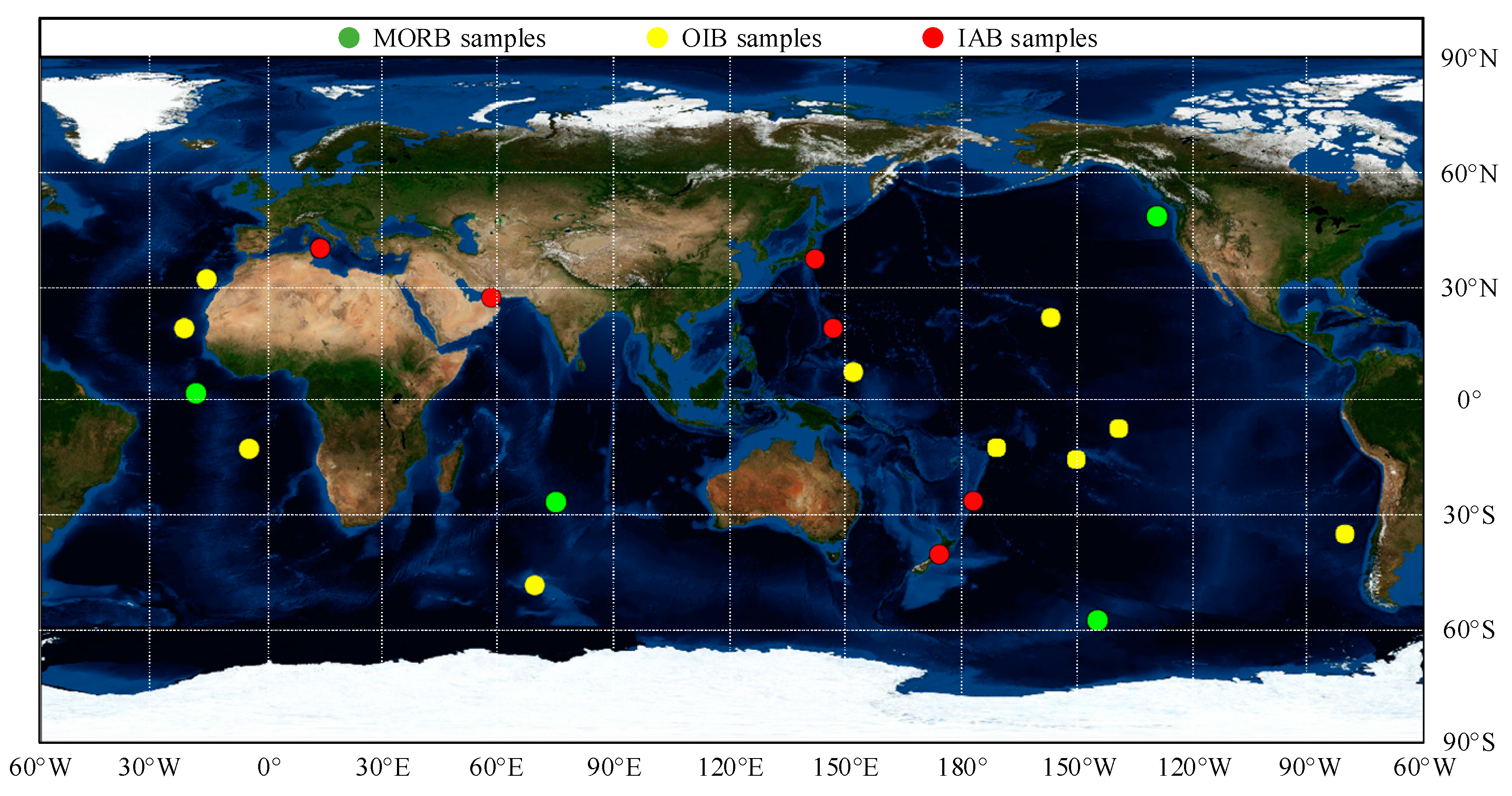
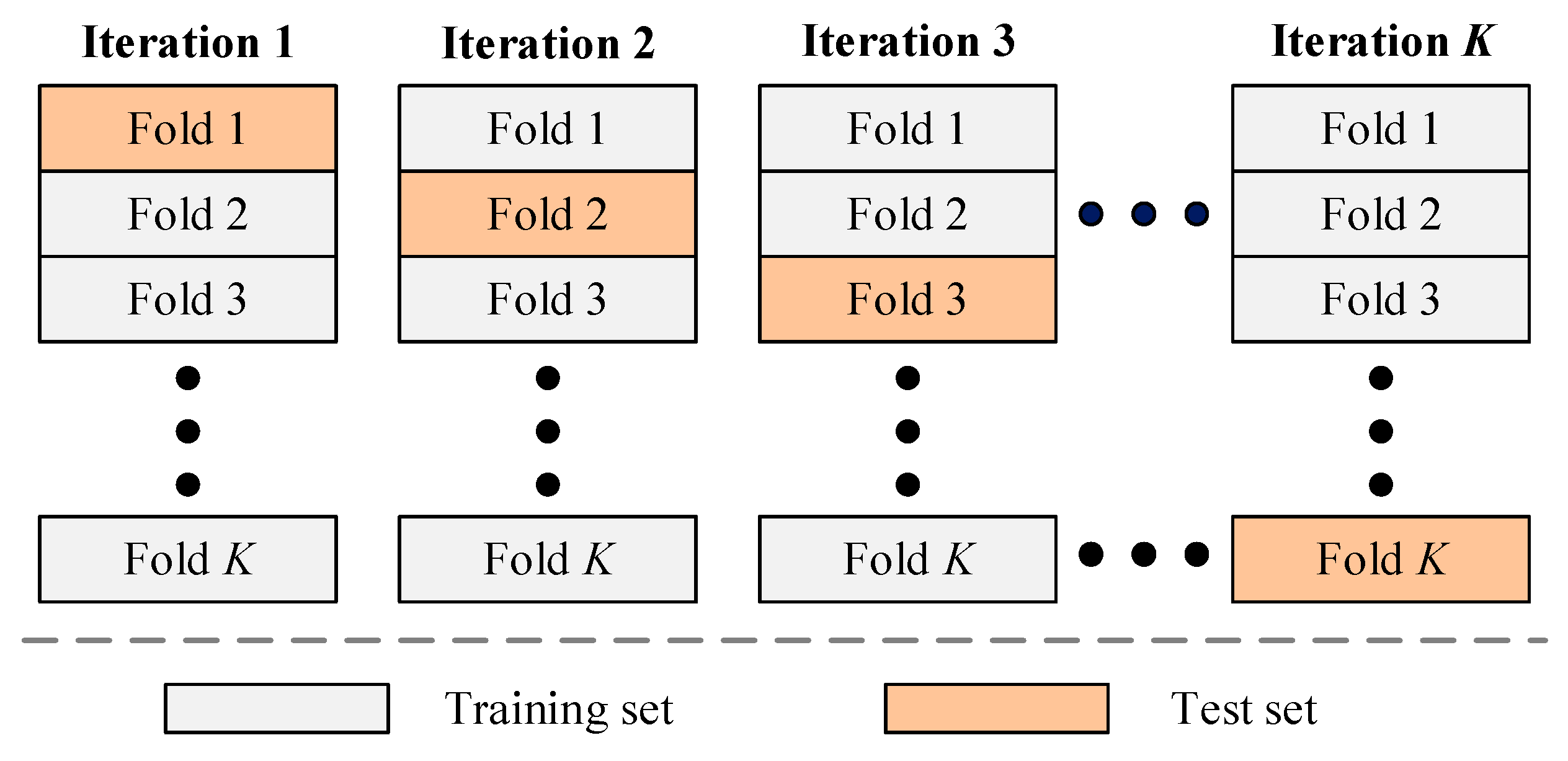
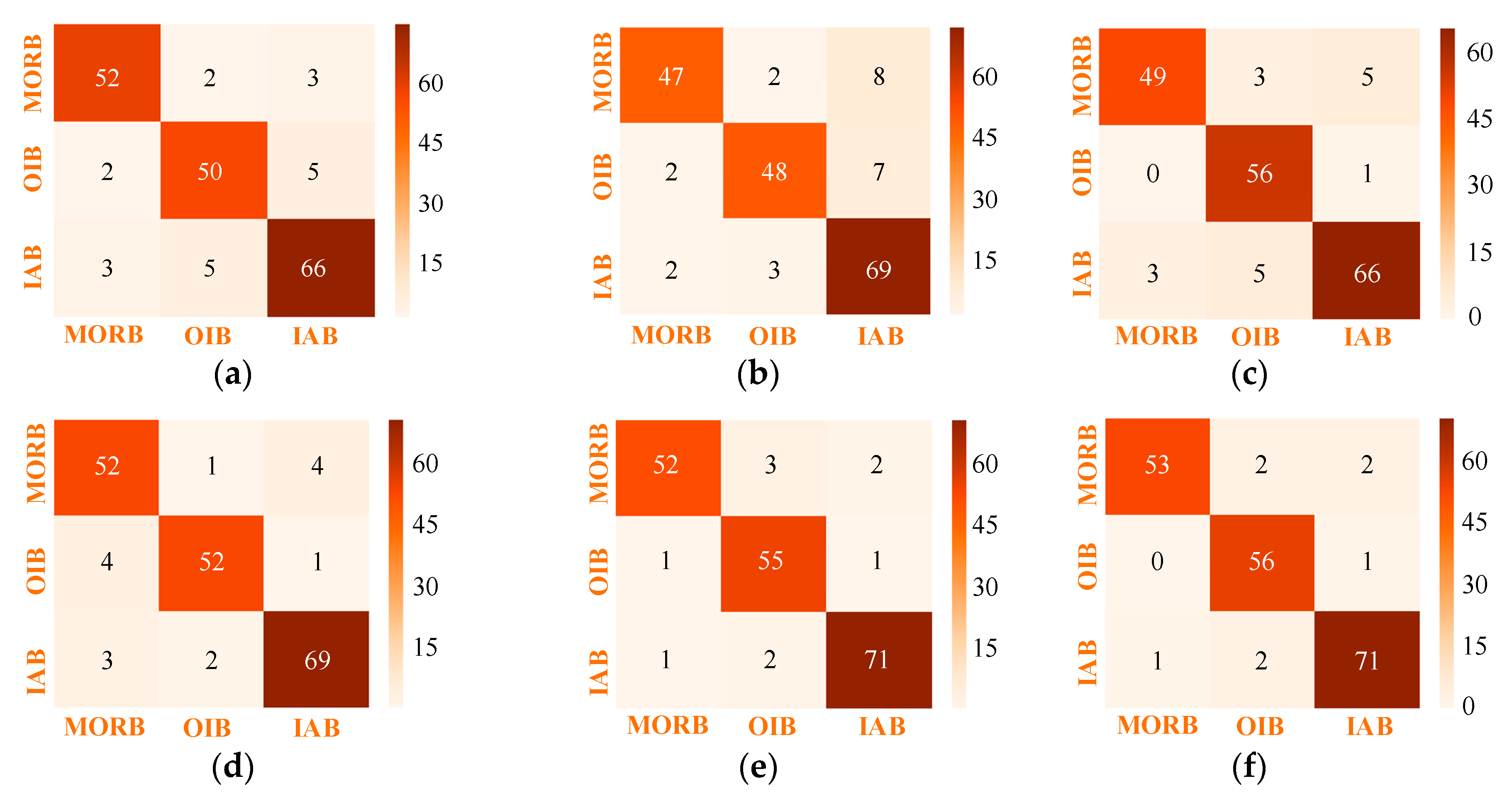


| Authors | MLAs | Rock Types | Tectonic Settings |
|---|---|---|---|
| Vermeesch [1] | CT | Basalt | MOR, OI and IA |
| Petrelli and Perugini [40] | SVM | Volcanic rocks | CA, IA, IOA, BAB, CF, MOR, OP and OI |
| Liu and Liu [3] | SVM and DT | Basalt | CP and PF |
| Ueki et al. [8] | SVM, RF and SMR | Volcanic rocks | CA, IA, IOA, BAB, CF, MOR, OP and OI |
| Han et al. [53] | NB, KNN, SVM and RF | Basalt | MOR, OI and IA |
| Jiao et al. [54] | SVM, KNN and RF | Gabbro | CF, CM, IV and OI |
| No. | Elements | Min. | Max. | Mean | No. | Elements | Min. | Max. | Mean |
|---|---|---|---|---|---|---|---|---|---|
| 1 | SiO2 | 36.55 | 54.30 | 49.15 | 27 | V | 27.00 | 622.00 | 284.65 |
| 2 | TiO2 | 0.18 | 4.91 | 1.81 | 28 | Cr | 0.00 | 3700.00 | 246.80 |
| 3 | Al2O3 | 8.52 | 26.16 | 15.71 | 29 | Co | 10.00 | 460.00 | 45.83 |
| 4 | Fe2O3 | 0.00 | 19.33 | 4.25 | 30 | Ni | 0.00 | 900.00 | 120.27 |
| 5 | FeOT | 1.24 | 15.11 | 7.61 | 31 | Cu | 5.00 | 6001.00 | 112.14 |
| 6 | CaO | 0.35 | 14.81 | 10.54 | 32 | Zn | 28.70 | 441.00 | 95.77 |
| 7 | MgO | 1.57 | 22.60 | 7.39 | 33 | Ga | 9.00 | 48.00 | 18.96 |
| 8 | MnO | 0.01 | 19.00 | 0.20 | 34 | Rb | 0.00 | 116.73 | 15.14 |
| 9 | K2O | 0.02 | 9.68 | 0.70 | 35 | Sr | 6.68 | 1590.00 | 385.88 |
| 10 | Na2O | 0.74 | 5.95 | 2.70 | 36 | Y | 7.00 | 296.00 | 30.86 |
| 11 | P2O5 | 0.01 | 2.35 | 0.29 | 37 | Zr | 0.00 | 988.30 | 145.80 |
| 12 | La | 0.00 | 317.00 | 17.09 | 38 | Nb | 0.00 | 130.00 | 19.17 |
| 13 | Ce | 0.00 | 420.00 | 36.85 | 39 | Sn | 0.45 | 12.00 | 2.00 |
| 14 | Pr | 0.36 | 26.20 | 5.86 | 40 | Cs | 0.00 | 5.00 | 0.32 |
| 15 | Nd | 0.00 | 780.00 | 21.36 | 41 | Ba | 1.30 | 1088.00 | 219.33 |
| 16 | Sm | 0.52 | 923.00 | 6.82 | 42 | Hf | 0.11 | 21.90 | 3.69 |
| 17 | Eu | 0.20 | 288.00 | 2.23 | 43 | Ta | 0.01 | 6.80 | 1.23 |
| 18 | Gd | 1.03 | 43.60 | 5.52 | 44 | Pb | 0.00 | 47.00 | 3.89 |
| 19 | Tb | 0.10 | 28.30 | 0.97 | 45 | Th | 0.00 | 27.00 | 2.47 |
| 20 | Dy | 0.00 | 594.00 | 7.93 | 46 | U | 0.00 | 6.20 | 0.74 |
| 21 | Ho | 0.29 | 6.10 | 1.01 | 47 | 143Nd/144Nd | 0.50 | 0.52 | 0.51 |
| 22 | Er | 0.80 | 259.00 | 3.58 | 48 | 87Sr/86Sr | 0.70 | 0.71 | 0.70 |
| 23 | Tm | 0.11 | 2.80 | 0.48 | 49 | 206Pb/204Pb | 17.08 | 38.46 | 18.93 |
| 24 | Yb | 0.26 | 193.00 | 3.38 | 50 | 207Pb/204Pb | 15.39 | 15.83 | 15.56 |
| 25 | Lu | 0.04 | 243.00 | 0.94 | 51 | 208Pb/204Pb | 18.83 | 40.17 | 38.29 |
| 26 | Sc | 0.00 | 88.00 | 34.95 |
| Elements | MORB | OIB | IAB | ||||||
|---|---|---|---|---|---|---|---|---|---|
| Min. | Max. | Mean | Min. | Max. | Mean | Min. | Max. | Mean | |
| K2O | 0.01 | 0.05 | 0.02 | 0.00 | 0.38 | 0.03 | 0.00 | 0.09 | 0.01 |
| CaO | 0.10 | 0.54 | 0.31 | 0.02 | 0.58 | 0.31 | 0.01 | 0.66 | 0.21 |
| SiO2 | 29.93 | 41.85 | 40.12 | 34.71 | 42.43 | 39.71 | 27.32 | 42.93 | 39.01 |
| MgO | 36.43 | 51.30 | 46.64 | 23.64 | 51.71 | 45.47 | 25.24 | 52.66 | 42.65 |
| NiO | 0.01 | 0.44 | 0.20 | 0.01 | 0.43 | 0.22 | 0.00 | 0.55 | 0.16 |
| Na2O | 0.01 | 0.10 | 0.02 | 0.00 | 0.53 | 0.14 | 0.00 | 0.21 | 0.02 |
| FeOT | 7.72 | 23.90 | 12.59 | 7.58 | 42.33 | 14.28 | 7.11 | 37.35 | 17.18 |
| TiO2 | 0.01 | 0.11 | 0.03 | 0.00 | 0.19 | 0.03 | 0.00 | 0.21 | 0.03 |
| Al2O3 | 0.01 | 0.55 | 0.06 | 0.00 | 0.95 | 0.09 | 0.00 | 0.94 | 0.06 |
| MnO | 0.01 | 0.53 | 0.20 | 0.03 | 0.73 | 0.21 | 0.08 | 0.76 | 0.27 |
| Cr2O3 | 0.01 | 0.21 | 0.06 | 0.00 | 0.23 | 0.05 | 0.00 | 0.29 | 0.04 |
| P2O5 | 0.01 | 0.14 | 0.07 | 0.01 | 0.10 | 0.03 | 0.00 | 0.12 | 0.02 |
| Tectonic Settings | Training Set | Test Set | Classification Accuracy (%) | |||||
|---|---|---|---|---|---|---|---|---|
| LRC | NB | MLP | SVM | RF | SONFIS | |||
| MORB | 239 | 57 | 91.23 | 82.46 | 85.96 | 91.23 | 91.23 | 92.98 |
| OIB | 262 | 57 | 87.72 | 84.21 | 98.25 | 91.23 | 96.49 | 98.25 |
| IAB | 249 | 74 | 89.19 | 93.24 | 89.19 | 93.24 | 95.95 | 95.95 |
| Total | 750 | 188 | 89.36 | 87.23 | 90.96 | 92.02 | 94.68 | 95.74 |
| Tectonic Settings | Training Set | Test Set | Classification Accuracy (%) | |||||
|---|---|---|---|---|---|---|---|---|
| LRC | NB | MLP | SVM | RF | SONFIS | |||
| MORB | 424 | 115 | 74.78 | 90.43 | 85.22 | 84.35 | 82.61 | 96.52 |
| OIB | 374 | 89 | 55.06 | 41.57 | 88.76 | 29.21 | 85.39 | 94.38 |
| IAB | 468 | 112 | 85.71 | 75.89 | 90.18 | 87.50 | 92.86 | 97.32 |
| Total | 1266 | 316 | 73.10 | 71.52 | 87.97 | 69.94 | 87.28 | 96.20 |
© 2019 by the authors. Licensee MDPI, Basel, Switzerland. This article is an open access article distributed under the terms and conditions of the Creative Commons Attribution (CC BY) license (http://creativecommons.org/licenses/by/4.0/).
Share and Cite
Ren, Q.; Li, M.; Han, S.; Zhang, Y.; Zhang, Q.; Shi, J. Basalt Tectonic Discrimination Using Combined Machine Learning Approach. Minerals 2019, 9, 376. https://doi.org/10.3390/min9060376
Ren Q, Li M, Han S, Zhang Y, Zhang Q, Shi J. Basalt Tectonic Discrimination Using Combined Machine Learning Approach. Minerals. 2019; 9(6):376. https://doi.org/10.3390/min9060376
Chicago/Turabian StyleRen, Qiubing, Mingchao Li, Shuai Han, Ye Zhang, Qi Zhang, and Jonathan Shi. 2019. "Basalt Tectonic Discrimination Using Combined Machine Learning Approach" Minerals 9, no. 6: 376. https://doi.org/10.3390/min9060376
APA StyleRen, Q., Li, M., Han, S., Zhang, Y., Zhang, Q., & Shi, J. (2019). Basalt Tectonic Discrimination Using Combined Machine Learning Approach. Minerals, 9(6), 376. https://doi.org/10.3390/min9060376







